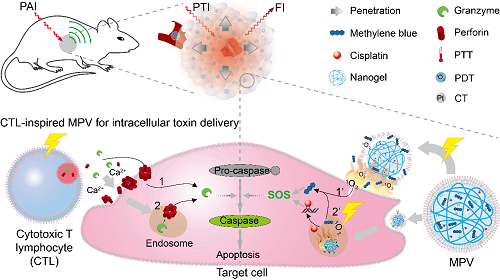
Cancer is one of the leading causes of death in the world. More recently, there is a significant focus on developing biomimetic nanomedicine for targeted cancer therapy. One major advantage of this approach is that the reliance of biological mechanism and tunable physiochemical properties can be integrated.
A research group led by Prof. LI Yaping from the Shanghai Institute of Materia Medica (SIMM) of the Chinese Academy of Sciences has focused on biomimetic nanomedicine. Recently, they explored the biomimetic strategy in creating cytotoxic T lymphocyte-mimic nanovesicle (MPV), a traceable bioinspired nanoparticle for the treatment of metastatic breast cancer.
In our body, specific cell eradication is common and dispensable to maintain homeostasis. For instance, immune cells as guardians of our body are able to recognize abnormal cells by checking the surface of cells they encountered, and then release toxins into the target cells to trigger their apoptosis. Unfortunately, the ability of the immune cells is suppressed in cancer patients.
The MPV contained a cell-membrane derived shell that sealing toxins (methylene blue and cisplatin) loaded nanogel up. Since the nanovesicles had "faces" similar to normal cells in the body, they could persist in the circulation and then leaked into the tumor.
Their accumulation in the tumor could be monitored in real-time, and the therapy could be turned on specifically in the tumor by laser in a way mimicking cytotoxic T lymphocyte (delivering toxins into target cells to trigger cell apoptosis) regardless of an immunosuppressive microenvironment.
The MPV, when used in combination with laser, induced partial regression of the primary tumors, and more importantly, inhibited 97% pulmonary metastasis.
The prove-of-concept work is limited by the fact that an external stimulus is required to switch on the treatment and all the experiments were performed in vitro or in animals. Despite the limitation of the work, the finding provides inspiration for the future design of biomimetic nanomedicine that can respond to chemical/physical/biological cues in the tumors.
The research was published online in Advanced Materials, and it was supported by the National Natural Science Foundation of China.

Schematic illustration of the working mechanism of CTL-mimetic nanovesicles (MPV) (Image by ZHANG Pengcheng)

86-10-68597521 (day)
86-10-68597289 (night)

86-10-68511095 (day)
86-10-68512458 (night)

cas_en@cas.cn

52 Sanlihe Rd., Xicheng District,
Beijing, China (100864)

